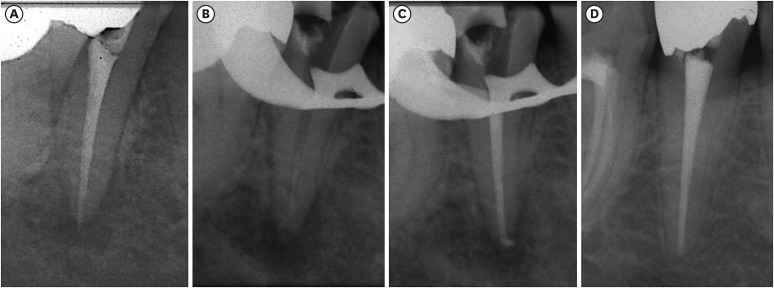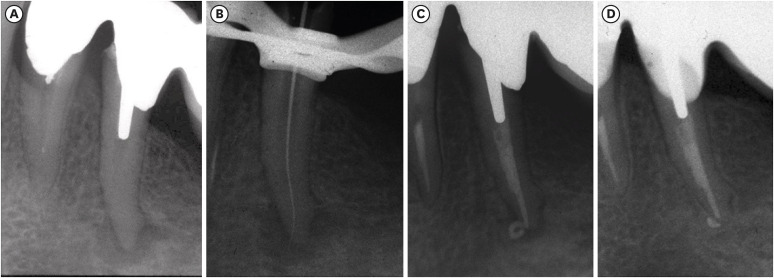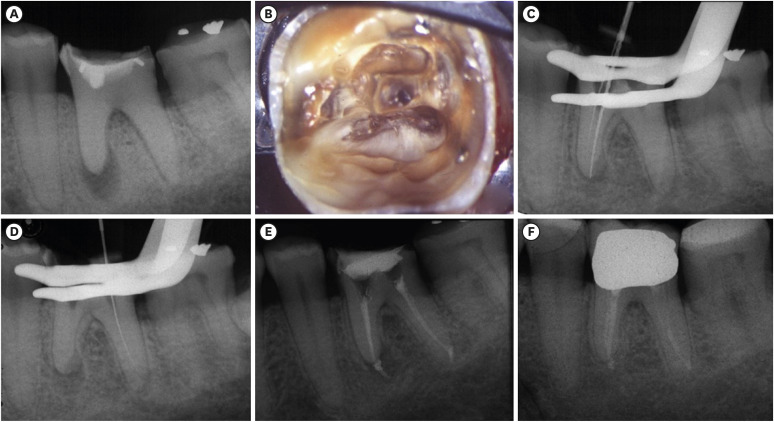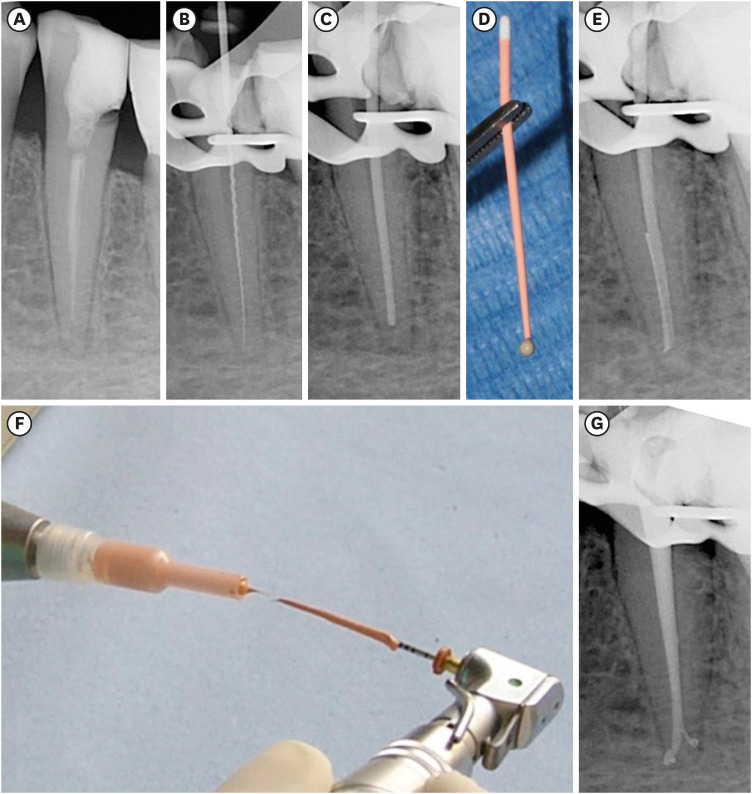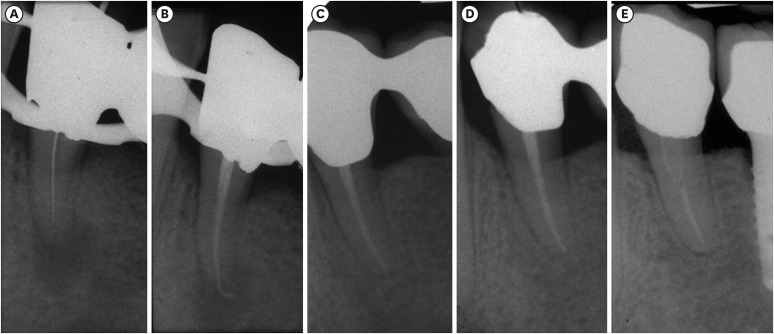Restor Dent Endod.
2021 May;46(2):e27. 10.5395/rde.2021.46.e27.
The fate of overfilling in root canal treatments with long-term follow-up: a case series
- Affiliations
-
- 1Unit of Endodontic, Department of Oral Science, Nano and Biotechnology, University “G. D'Annunzio” of Chieti, Chieti, Italy
- 2Department of General Surgery and Medical-Surgical, University of Catania, Catania, Italy
- 3Grande Plotino and Torsello Studio di Odontoiatria, Rome, Italy
- KMID: 2548071
- DOI: http://doi.org/10.5395/rde.2021.46.e27
Abstract
- This study describes 6 cases of endodontic overfilling with successful clinical outcomes during long-term (up to 35 years) radiographic follow-up. Successful endodontic treatment depends on proper shaping, disinfection, and obturation of root canals. Filling materials should completely fill the root canal space without exceeding the anatomical apex. Overfilling may occur when the filling material extrudes into the periapical tissues beyond the apex. The present case series describes 6 root canal treatments in which overfilling of root canal sealer and gutta-percha accidentally occurred. Patients’ teeth were periodically checked with periapical radiographs in order to evaluate the outcomes during long-term follow-up. All cases showed healing and progressive resorption of the extruded materials in the periapex. The present cases showed that if a 3-dimensional seal was present at the apical level, overfilling did not negatively affect the long-term outcomes of root canal treatment.
Figure
Reference
-
1. Sjögren U, Figdor D, Persson S, Sundqvist G. Influence of infection at the time of root filling on the outcome of endodontic treatment of teeth with apical periodontitis. Int Endod J. 1997; 30:297–306. PMID: 9477818.
Article2. Nair PN. On the causes of persistent apical periodontitis: a review. Int Endod J. 2006; 39:249–281. PMID: 16584489.
Article3. Sritharan A. Discuss that the coronal seal is more important than the apical seal for endodontic success. Aust Endod J. 2002; 28:112–115. PMID: 12510475.
Article4. Schaeffer MA, White RR, Walton RE. Determining the optimal obturation length: a meta-analysis of literature. J Endod. 2005; 31:271–274. PMID: 15793382.
Article5. Gutmann JL, Witherspoon DE. Obturation of the cleaned and shaped root canal system. In : Cohen S, Burns RC, editors. Pathways of the pulp. 8th ed. St. Louis, MO: Mosby;2002. p. 293–364.6. Kuttler Y. Microscopic investigation of root apexes. J Am Dent Assoc. 1955; 50:544–552. PMID: 14366934.
Article7. Stein TJ, Corcoran JF. Radiographic “working length” revisited. Oral Surg Oral Med Oral Pathol. 1992; 74:796–800. PMID: 1488238.
Article8. Martins JN, Marques D, Mata A, Caramês J. Clinical efficacy of electronic apex locators: systematic review. J Endod. 2014; 40:759–777. PMID: 24862702.
Article9. Benenati FW. Obturation of the radicular space. In : Ingle JI, Bakland LK, Baumgartner JC, editors. Ingle's endodontics. 6th ed. Hamilton, ON: BC Decker Inc;2008. p. 1054–1055.10. Malagnino VA, Rossi-Fedele G, Passariello P, Canullo L. ‘Simultaneous technique’ and a hybrid Microseal/PacMac obturation. Dent Update. 2011; 38:477–478. PMID: 22046908.
Article11. McSpadden J. Multiphase gutta-percha obturation technique. Dent Econ. 1993; 83:95–97. PMID: 8150190.12. Maggiore F. MicroSeal systems and modified technique. Dent Clin North Am. 2004; 48:217–264. PMID: 15066515.
Article13. Cathro PR, Love RM. Comparison of MicroSeal and System B/Obtura II obturation techniques. Int Endod J. 2003; 36:876–882. PMID: 14641428.
Article14. Gutiérrez JH, Brizuela C, Villota E. Human teeth with periapical pathosis after overinstrumentation and overfilling of the root canals: a scanning electron microscopic study. Int Endod J. 1999; 32:40–48. PMID: 10356468.
Article15. Pascon EA, Leonardo MR, Safavi K, Langeland K. Tissue reaction to endodontic materials: methods, criteria, assessment, and observations. Oral Surg Oral Med Oral Pathol. 1991; 72:222–237. PMID: 1833711.
Article16. Aminoshariae A, Kulild JC. The impact of sealer extrusion on endodontic outcome: a systematic review with meta-analysis. Aust Endod J. 2020; 46:123–129. PMID: 31449355.
Article17. Endo MS, Ferraz CC, Zaia AA, Almeida JF, Gomes BP. Quantitative and qualitative analysis of microorganisms in root-filled teeth with persistent infection: monitoring of the endodontic retreatment. Eur J Dent. 2013; 7:302–309. PMID: 24926210.
Article18. Siqueira JF Jr, Rôças IN, Ricucci D, Hülsmann M. Causes and management of post-treatment apical periodontitis. Br Dent J. 2014; 216:305–312. PMID: 24651336.
Article19. Dahl JE. Toxicity of endodontic filling materials. Endod Topics. 2005; 12:39–43.
Article20. Tavares T, Soares IJ, Silveira NL. Reaction of rat subcutaneous tissue to implants of gutta-percha for endodontic use. Endod Dent Traumatol. 1994; 10:174–178. PMID: 7995248.
Article21. Gutiérrez JH, Gigoux C, Escobar F. Histologic reactions to root canal fillings. Oral Surg Oral Med Oral Pathol. 1969; 28:557–566. PMID: 5259038.
Article22. Feldman G, Solomon C, Notaro PJ. Resorption of gutta-percha in the apical region. Oral Surg Oral Med Oral Pathol. 1965; 20:102–103.
Article
- Full Text Links
- Actions
-
Cited
- CITED
-
- Close
- Share
- Similar articles
-
- Prognosis of the Apical Fragment of Root Fractures after Root Canal Treatment of Both Fragments in Immature Permanent Teeth
- Diagnosis and treatment of maxillary molar with abnormality
- Treatment of horizontal root-fractured maxillary incisors
- Root canal treatment of a mandibular second premolar with three separate root canals
- A Study of Root Canals Morphology in Primary Molars using Computerized Tomography

